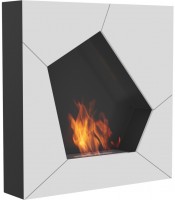What is a biofireplace?

The principle of operation of the biofireplace
Biofireplace gives a living flame, but it does not need a chimney at all. The device of a biofireplace is extremely simple: a fuel tank, a damper and a decorative finish. Biofireplaces of the simplest design, devoid of decor, are called burners.
Instead of wooden logs, a special liquid is placed in the fuel tank (less than a third of the volume) — bioethanol, which is a mixture of ethyl alcohol and a number of additional substances. When burned, bioethanol decomposes into ordinary water, or rather steam, and carbon dioxide, that is, it does not emit harmful substances (if we are talking about high-quality biofuels) and does not leave soot and soot. It is not worth pouring biofuel with a margin, since during the downtime of the fireplace it will simply evaporate.
One liter of biofuel, depending on its quality and the width of the fireplace damper, burns from 3 to 4 hours. Throughout this time, you can not only enjoy the aesthetics of a living flame, but also auxiliary heat the room. The heating efficiency depends on the specific model of the biofireplace. The average heat output is 3 to 5 kW, which is more than a wood-burning fireplace and even an electric oil cooler or convector.
Careful use of a biofireplace is completely safe for human health and life, but, of course, if the operating rules are not followed, an open flame can lead to a fire. The maximum permissible flame height and, accordingly, the rate of combustion of bioethanol is regulated by a special damper. With its help, you can quickly put out the fireplace. Despite the absence of the need for a chimney, it is recommended to install a biofireplace in a room with a ventilation hood or at least a window that opens periodically.
 |
Classification of biofireplaces
The variety of decor materials (glass, plastic, stone, ceramics, wood and metal) allow biofireplaces to fit perfectly into the interior of not only apartments and private houses, but also cafeterias, restaurants, hotels and spas. In large areas, especially with a frequently opened street door, it is more reasonable to install several bio-fireplaces in the corners.
According to the installation method, biofireplaces are divided into floor, mobile, built-in, wall and desktop. Floor stands are most often stationary, but if necessary they can be transferred (if not alone, then two or three together). Classic floor models imitate a wood-burning fireplace sheathed with stone or brick tiles. For even greater similarity with the classics, a dummy log made of refractory ceramics is placed inside. Other floor tiles can have a wide variety of shapes, sizes and decor. For example, in the form of a vertical pipe to take up a minimum of space in the room.
There are also mobile outdoor fireplaces, the appearance of which is much more modest — a metal or glass box with wheels for easy transportation. Less common are double-sided bio-fireplaces, which divide a large room into zones, as well as corner and built-in tables — especially for small rooms.
 |
Built-in bio-fireplaces, which are embedded in the wall, also “mow” under the classics. It is much easier to install wall -mounted closed-type models with a usually simple design, popular among lovers of loft-style interiors (brick walls, beams on the ceiling) or high-tech (minimalism, white and grey tones, an abundance of glass and metal).
Desktop biofireplaces are the most compact of all. Their purpose is purely decorative, because of their small size they almost do not heat. Outdoor bio-fireplaces, on the contrary, are made deliberately bulky and heavy, so that they do not accidentally turn over and steal. Used in parks and gardens. If desired, they can be installed indoors, but this is not their main task.
According to the method of control, biofireplaces are divided into mechanical or automatic. Mechanical ones are driven by a lighter or special long fireplace matches, and the burning power is manually regulated by a damper.
Automatic biofireplaces, in addition to turning on and adjusting the power by pressing buttons or a touch screen (connection to a household power supply is required), have fire sensors, a sleep timer (automatically turn off after a specified time), a child lock and can even be connected to a centralized smart home system with temperature control.
 |
Bio fireplace manufacturing companies
The most famous manufacturers of bio-fireplaces are Kratki and Planika (both from Poland), Spartherm (Germany) and Decoflame (Denmark). Kratki products are notable for their low cost with relatively advanced functionality (for example, adjusting the intensity of combustion), as well as a rich choice of decor options.
Spartherm biofireplaces, on the contrary, are considered premium. It is this company that, usually, is the first to introduce new technologies and decorative materials, but also asks for solid money.
findings
A biofireplace is really needed, of course, not for everyone. First of all, it is a stylish element of home decor, and only secondly, a heating device. Nevertheless, it can still bring practical benefits, especially in early autumn and late spring, when it is cool outside, and the heating season has not yet begun or, on the contrary, has already ended. The main thing is not to buy surrogate biofuel without the manufacturer's label and follow the simplest fire safety rules.
A table LED lamp, a thermal mug and three more useful devices for office workers.
Integrity above all else! Five compact travel irons.
16 cores in a home computer? Easy with AMD Threadripper processors!
A climbing tripod, a 4K monitor for working with graphics, and three other equally useful devices.
How to choose a rangefinder suitable for a certain type of work?










